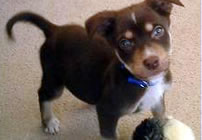 Ensure your pup’s on his best behavior
Ensure your pup’s on his best behavior
Prevent accidents and mishaps with our favorite puppy training tips and techniques from the industry’s top dog training professionals
A well-behaved puppy grows into a well-behaved dog. Whether your goal is to housetrain your new pup or teach him not to beg at the dinner table, it’s important to start your training methods early, before bad habits become too ingrained in his behavior.
We consulted with some renowned professional puppy trainers to compile a list of the most important do’s and don’ts when training a young dog:
- When housetraining a puppy, patience is key. Don’t expect your pup to be fully housebroken until she’s about six months old. If you have to leave for work every day, you’ll most likely need to use the crate training method to prevent damage to your home while you’re away.
- To help a puppy become acclimated to her new environment, provide a dedicated spot for her to sleep and rest. In cold months, use a hot water bottle to create a toasty haven. This will help to ease your pup’s anxiety and prevent her from acting out by behaving badly.
- Remember that it’s possible to train your puppy too much. Don’t expect her to obey complex commands or perform the same actions as an older dog. At the puppy stage, you should focus primarily on housetraining and basic good manners.
- To discourage your puppy from nipping or biting, let out a dramatic yelp or howl to indicate that this is an undesirable action. Smacking or scolding your puppy is likely to cause hurt feelings and confusion rather than rectifying the behavior.
- One of the most undesirable tendencies of an overeager puppy is jumping up on people. The best way to deter this is to ignore the dog and refrain from petting or talking to her when she indulges in this behavior.
- Call the dog by her name often, not just when you’re reprimanding her for a negative action. When you use her name to announce mealtimes, praise good behavior, or just to express your affection, she’ll be more likely to respond when called, and will associate her name with positive as well as negative interaction.
- When training your puppy, stick to the same phrases and repeat them often. This will help your new pet learn basic vocabulary, such as “No!” and “Outside” and “Get down!”
With her eagerness and unpredictability, a new puppy demands near-constant attention and monitoring. By keeping a close eye on your new pet, you’ll be better equipped to help prevent some of the common accidents that are likely to occur.

